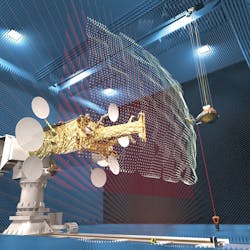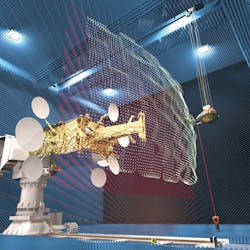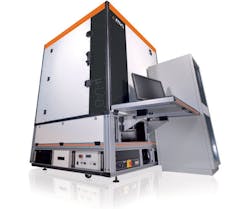Test Chambers Analyze Mega- To Micro-Sized Antennas
This file type includes high resolution graphics and schematics when applicable.
Antenna design is quickly advancing as space-borne antennas grow bigger, millimeter-wave technology increases density, gallium-nitride (GaN) technology widens bandwidth, and radar systems push the boundary on radiated power. The extremes of antenna size, power, bandwidth, and complexity are clearly expanding. These advancements are placing a serious burden on antenna test systems. As technology evolves to allow more complex and higher-bandwidth electronics, test and measurement equipment is able to better scale with the devices.
But these advancements do not aid the test-chamber and test-planning engineers. As a result, test antenna companies that offer anechoic, near-field, far-field, high-power, and wide-bandwidth test chambers have to take more creative approaches. This need is underscored by the fact that the environments and platforms in which these antennas operate are becoming more diverse and electrically populated.
From space-borne to airborne and automotive platforms, multiband antennas and multi-antenna systems are finding their way into every human-populated environment. This makes highly accurate radiation tests critical and often necessary for licensing purposes. Yet it is usually difficult to test larger antenna structures, as the cost of shipping and assembly is prohibitive. A creative solution to this problem is currently being prototyped by Astrium GmbH in conjunction with the European Space Agency as part of the Advanced Research in Telecommunications Systems (ARTES) program.
The Portable Antenna Measurement System (PAMS) is being designed to handle cases where it is difficult and expensive to build a dedicated test site or ship large antennas to test sites (Fig. 1). The system comprises a multi-sensor node that can be suspended and supported using the existing crane infrastructure of a satellite or antenna assembly facility. Modular anechoic shielding can be placed around the antenna under test (AUT) for accurate antenna measurements. The AUT also can be placed in an echoic environment for diagnostic antenna measurements. The current PAMS prototype is being demonstrated in a facility at the Astrium Antenna Test Centre in Munich, Germany.
The PAMS performs near-field (NF) testing by probing with a technique called the Fast Irregular Antenna Field Transformation Algorithm (FIAFTA). This algorithm uses the concept of plane-wave expansion. Its speed is enhanced with the Multilevel Fast Multipole Method (MLFMM). With this approach, the PAMS isn’t bound by precise geometric scan profiles and contours. As a result, it doesn’t have to go through a whole matrix of a measurement grid to maintain accuracy. The system can work in a free-form NF probing scheme with the exact position of the probe actively tracked by commercially available laser trackers.
Because the PAMS uses the assembly infrastructure for the large antenna, measurement volume isn’t limited by test-site dimensions. As a result, the PAMS can be used to test a satellite during assembly, in an integrated test facility, or even at the launch site after the satellite has been transported. The PAMS probe also can be modularly equipped with probes designed for the specific frequency range desired for testing. The current prototype is designed to test in the L-band and 33-GHz area of the K-band for performance verifications this summer.
Astrium also offers traditional antenna test facilities, which are capable of performing measurements for gain, swept frequency, multi-frequency, equivalent isotropically radiated power (EIRP), multi-beam, polarimetric radar-cross section (RCS), and radar pulse modes. Among these solutions are the Compact Antenna Test Range CCR 75/60, Cylindrical Near-field Test Range CNTF-8, and Feed Calibration Test Chamber. The CCR 75/60, which measures 5 × 5 × 6 m, covers frequency ranges from 1.5 to 200 GHz with optional 500-GHz capability. It is well suited for multi-beam and multi-frequency antenna-pattern measurements of dual linear or circular polarizations (Fig. 2).
In contrast, the CNTF-8 offers a planar test area of 10 × 8 m or a cylindrical test area of 6 x 8 m. The CNTF-8 covers 400 MHz to 100 GHz with a temperature capability of -60° to +80° C). It is primarily designed for the acceptance and qualification of lightweight and high-gain spacecraft antennas.
The Feed Calibration Test Chamber is designed for calibration measurements of various feed systems and NF probes for spacecraft antennas. The test zone area is 0.8 × 0.8 × 0.8 m. The chamber can test systems to 40 GHz sunder the same temperature conditions as the CNTF-8. For those looking to extend test power, environmental conditions, and security, another option is Raytheon’s Antenna Test Facility (ATF) in El Segundo, Calif. The ATF is designed for testing prototype antenna technologies for space, advanced radar, communications, and airborne systems.
This file type includes high resolution graphics and schematics when applicable.
Anechoic Advantage
This file type includes high resolution graphics and schematics when applicable.
Sporting a six-floor and 17,000-square-foot facility, the ATF’s indoor anechoic chambers and compact ranges are protected against environmental conditions and exterior RF interference. The chambers’ exterior RF interference attenuation is greater than 100 dB to 100 GHz. There are four chambers within the ATF that can be used simultaneously. Chambers 1 and 2 feature compact ranges integrated within the anechoic chamber. Each chamber is equipped with positioners for rotating antennas, analysis software equipment, control-room instrumentation, and processing equipment.
An anechoic tapered chamber provides NF and far-field (FF) measurement capability with cylindrical, spherical, or planar methods. This chamber can be equipped with instruments that enable testing from 0.2 to 34 GHz, 0.1 to 110 GHz, and even to 140 GHz. The planar-near-field (PNF) range has a 10-×-10-ft. chamber that can house antennas to 8 ft. for 6-to-18-GHz testing using Nearfield Systems’ PC-driven data-acquisition software. Additional equipment can enhance this chamber for analysis to 110 GHz. For antenna heavy lifting, the Georgia Tech Research Institute (GTRI) offers a variety of test chambers and ranges to support the largest loads.
In fact, the GTRI also boasts electromagnetic test and evaluation facilities spanning 200 MHz to 110 GHz in the NF and FF ranges. The GTRI features a planar/cylindrical NF range, a spherical NF range, an anechoic chamber, an outdoor FF range, and a turntable range. The turntable range can support a load in excess of 200,000 lbs. and can elevate approximately 90 ft. above the tower base. This elevation capability enables the range to test tank-sized targets to 32 deg. of elevation at different angles. It also can support vehicle-mounted antennas. On the outdoor FF range, a three-axis positioner can support 30-ft.-diameter antennas to 30,000 lbs. while providing high mechanical precision.
For those engineers looking to test high frequencies in small spaces, the Microwave Vision Group offers the μ-Lab (Fig. 3). This portable millimeter-wave test chamber measures 7 × 5 × 5 ft. It is mounted on caster wheels with a folding tabletop side for an attached peripheral computer. The test chamber can support devices to laptop size. It boasts an offset column for chip measurements that can support devices to 5 × 5 cm. The frequency capability of the μ-Lab is 50 to 110 GHz with add-ons that can drop the frequency range to 18 GHz. To specifically test NF and FF chips, miniature connectorized antennas, and portable electronics, the μ-Lab has highly refined elevation and azimuth-axis control assemblies.
This file type includes high resolution graphics and schematics when applicable.
About the Author
Jean-Jacques DeLisle
Jean-Jacques graduated from the Rochester Institute of Technology, where he completed his Master of Science in Electrical Engineering. In his studies, Jean-Jacques focused on Control Systems Design, Mixed-Signal IC Design, and RF Design. His research focus was in smart-sensor platform design for RF connector applications for the telecommunications industry. During his research, Jean-Jacques developed a passion for the field of RF/microwaves and expanded his knowledge by doing R&D for the telecommunications industry.




